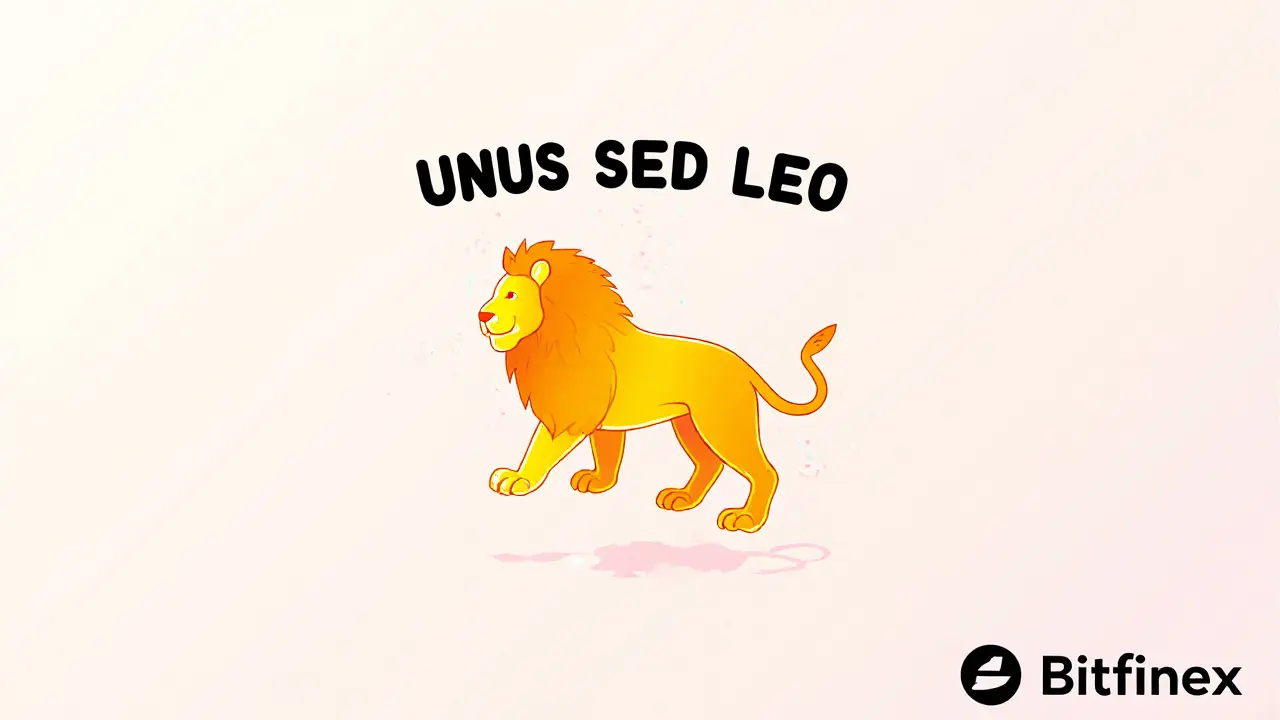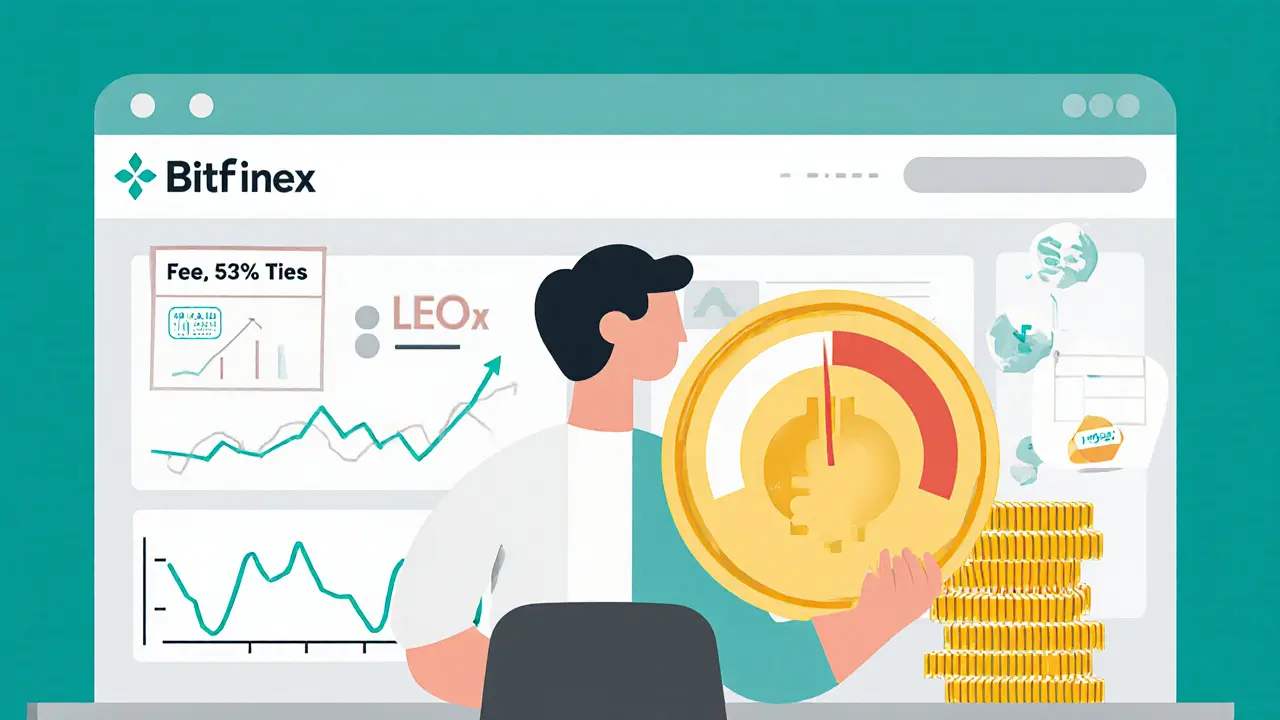What Is UNUS SED LEO (LEO) Crypto Coin? A Complete Guide
 Feb, 27 2025
Feb, 27 2025
LEO Fee Calculator
Calculate Your LEO Savings
See how much you could save on Bitfinex trading fees by holding LEO tokens.
Enter values to see your potential savings
When you hear the name UNUS SED LEO, you might wonder whether it’s another meme coin or a serious utility token. In plain English, LEO is the native token of the Bitfinex exchange, built to cut trading fees and fund a transparent buy‑back‑and‑burn program. Below we break down what LEO is, how it works on two blockchains, why it matters for traders, and what risks you should watch.
What Is UNUS SED LEO?
UNUS SED LEO is a utility token created by iFinex Inc., the parent company of the Bitfinex exchange and the Tether stablecoin platform. Launched publicly in May 2019 after a private sale that raised roughly $1 billion in USDT, LEO’s primary purpose is to give Bitfinex users fee discounts and to generate steady buy‑back pressure on the token supply.
Why "UNUS SED LEO"? The Story Behind the Name
The Latin phrase "UNUS SED LEO" translates to "one, but a lion." It references Aesop’s fable where a fox reproaches a lion for having only one offspring, implying quality over quantity. Bitfinex chose the name to signal that a single token can pack a powerful punch for its ecosystem.
Technical Foundations: Dual‑Chain Architecture
LEO exists on two networks at the same time: the Ethereum blockchain as an ERC‑20 token and the EOS blockchain. This dual‑chain design is rare; it lets users move LEO between the two ecosystems without a separate bridge, while still benefiting from Ethereum’s wide wallet support and EOS’s fast transaction finality. Both smart contracts have been audited by independent firms, and the audit reports are posted on Bitfinex’s transparency portal.
How LEO Reduces Trading Fees
Bitfinex applies tiered discounts based on the amount of LEO you hold in your exchange wallet:
- 1‑100 LEO → 15% off spot‑trading fees
- 101‑1,000 LEO → 20% off spot‑trading fees
- Over 1,000 LEO → 25% off spot‑trading fees
The same tiers apply to lending, borrowing, and margin‑trading fees, making LEO especially attractive to high‑frequency traders. Users don’t need to claim the discount-Bitfinex automatically applies it whenever a qualifying balance is detected.
Buy‑Back‑And‑Burn: The Deflationary Engine
Every quarter, iFinex pledges 15% of its net profits to purchase LEO on the open market and permanently destroy the tokens. By Q2 2023, more than 1.66 million LEO had been burned, accounting for roughly 3.9% of the original 1 billion supply. The burn tracker dashboard, live on Bitfinex, shows each batch’s price and volume, offering full transparency to token holders.
LEO vs. Other Exchange Tokens
| Feature | UNUS SED LEO | Binance Coin (BNB) |
|---|---|---|
| Primary ecosystem | Bitfinex exchange (fee discounts, limited utilities) | Binance ecosystem (trading, launchpad, BSC, NFTs) |
| Blockchain(s) | Ethereum ERC‑20 & EOS | Binance Smart Chain (BEP‑20) & Ethereum |
| Supply model | 1 billion, ongoing buy‑back‑and‑burn | 200 million fixed, periodic burns |
| Discount tier | 15‑25% fee reduction based on holdings | Up to 25% fee discount on Binance, plus other perks |
| Market cap (Oct 2023) | ≈$1.2 billion | ≈$54 billion |
Both tokens aim to lock users into their native platforms, but LEO’s utility is narrower, focusing almost exclusively on fee discounts. BNB enjoys a broader developer ecosystem, which makes it more versatile outside its exchange.
Who Benefits Most from Holding LEO?
If you trade large volumes on Bitfinex, the fee savings can quickly outweigh the token’s price volatility. For example, a trader moving $500,000 in spot volume each month and holding 1,200 LEO would save roughly $3,000 in fees-equivalent to a 2.5% return on a $120,000 LEO position. Conversely, casual investors who never use Bitfinex’s services gain little from the token and expose themselves to issuer‑specific risk.

Risks and Controversies
LEO’s fortunes are tightly coupled to Bitfinex’s health. The exchange faced legal scrutiny from the New York Attorney General in 2019, paid a $18.5 million penalty, and had to adopt strict transparency measures. While those steps birthed the token’s burn mechanism, they also signal regulatory risk. Moreover, the token lacks native yield‑generating features common in DeFi tokens, so price appreciation relies largely on fee‑discount demand and the perception of a shrinking supply.
How to Get Started with LEO
- Open a Bitfinex account and complete KYC (average 72 hours).
- Deposit USDT or another supported asset.
- Buy LEO on the Bitfinex spot market or transfer from an external wallet (ERC‑20 or EOS version).
- Hold the desired amount in your exchange wallet to trigger the discount tier.
- Monitor the LEO Burn Tracker to see how much supply is being removed.
The learning curve is modest; CryptoZombie Academy rates the process a 3.2/10 in difficulty, mainly because of the dual‑chain logistics.
Future Outlook
Bitfinex plans to expand LEO’s utility to its upcoming NFT marketplace and possibly to the Ethfinex DEX. Analysts at Messari warn that the token’s relevance will wane if Bitfinex’s quarterly net profit falls below $10 million, a threshold it has missed only twice in the last 14 quarters. If the exchange regains a larger share of global volume, LEO could climb back into the top‑50 tokens by market cap.
Bottom Line
UNUS SED LEO is not a speculative meme; it is a functional, fee‑discount token built for Bitfinex traders. Its value proposition shines when you actively use the exchange, but it offers limited upside for passive investors. Understanding the burn schedule, dual‑chain mechanics, and the regulatory backdrop will help you decide whether LEO fits your crypto strategy.
What is the main use case of LEO?
LEO’s primary purpose is to give Bitfinex users tiered fee discounts on trading, lending, and borrowing. The token also funds a quarterly buy‑back‑and‑burn program that reduces supply.
Can I use LEO on other platforms?
Currently LEO’s utility is limited to the Bitfinex ecosystem. While you can hold the token in any ERC‑20 or EOS wallet, its benefits only apply on Bitfinex.
How does the burn mechanism work?
Every quarter iFinex allocates 15% of its net profits to purchase LEO on the open market. The bought tokens are then sent to an unspendable address, effectively removing them from circulation.
What are the fee‑discount tiers?
1‑100 LEO = 15% discount, 101‑1,000 LEO = 20% discount, over 1,000 LEO = 25% discount on spot‑trading fees. Same tiers apply to margin and lending fees.
Is LEO a good long‑term investment?
If you trade heavily on Bitfinex, the fee savings can make LEO worthwhile. As a pure speculative asset, its outlook is tied to Bitfinex’s financial health and regulatory standing, which adds extra risk.
Clarice Coelho Marlière Arruda
October 25, 2025 AT 20:17Brian Collett
October 26, 2025 AT 00:28Wayne Overton
October 26, 2025 AT 09:55Alisa Rosner
October 27, 2025 AT 07:14MICHELLE SANTOYO
October 28, 2025 AT 00:13Lena Novikova
October 28, 2025 AT 04:24Olav Hans-Ols
October 28, 2025 AT 18:29Nick Cooney
October 29, 2025 AT 08:14Allison Andrews
October 30, 2025 AT 00:11Kevin Johnston
October 30, 2025 AT 18:31Dr. Monica Ellis-Blied
October 31, 2025 AT 02:08Herbert Ruiz
October 31, 2025 AT 10:15